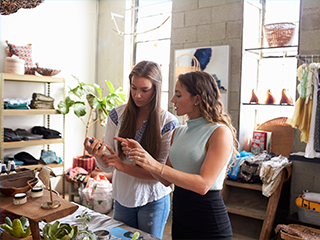
The rising popularity of global e-commerce platforms has thrown the relevance of traditional bricks and mortar retailing under the microscope.
However, new research from Mood Media, conducted by Walnut Unlimited suggests that when presented with an immersive shopping experience, Australian consumers regularly prefer the appeal of traditional retail.
The global study, titled ‘Elevating the Customer Experience: The Impact of Sensory Marketing’ surveyed more than 10,000 consumers across 10 countries, charting the values and motivations that drive sales and consumer loyalty.
“Consistent with our 2017 State of Brick & Mortar study, we found that the physical store remains important to the majority of people around the world, with the experiential element playing a large role in consumers’ decision to choose brick and mortar over e-commerce,” said Scott Moore, global senior vice president of marketing and creative content for Mood Media.
“It also further highlights that brick and mortar businesses have to give consumers a reason to get off the sofa and into the store, and part of that reason lies in providing them an elevated sensorial experience. Brands should look to this report to discover how they can create the kinds of store environments that will convert shoppers into buyers and loyal repeat customers.”
So, what are the in-store elements bricks and mortar retailers should be accentuating to drive drive customers?
Atmosphere
According to the report, Australian shoppers value atmosphere as a key indicator of a strong physical retail experience.
Over 86 per cent of Australians stated they were very/fairly likely to re-visit a store with enjoyable atmosphere, with 70 per cent of Australians reporting they were very/fairly likely to stay longer in store.
Steve Hughes, managing director of Mood Media Australia said the results demonstrated that there was still a strong demand for bricks and mortar retailing.
“Consumers want to enjoy the experience of shopping and this is something that online stores simply cannot offer,” Hughes said.
For consumers however, a positive retailing extends beyond just a beautiful store, with Hughes suggesting a complete sensorial experience is critical to sales growth.
“Attracting shoppers with an enticing atmosphere and then encouraging purchases with a hands-on experience are key to increasing purchases.”
Music and smell
Music was identified as the number one factor impacting a shopper’s mood in store, with 62 per cent of Australians reporting they have enjoyed listening to music in-store recently, with 45 per cent admitting they have stayed in a store longer than anticipated because they enjoyed the music.
“Music is such an important component in the shopping experience. It can lift the mood, create a calming atmosphere that drives shoppers to take their time, and even give the staff an all-important pep-up in the afternoon,” continued Hughes.
“A carefully curated playlist can increase the daily takings, time in-store and repeat store visits.”
Furthermore, the research went on to show that 63 per cent of Australian shoppers noticed a store’s smell, revealing the need for a comprehensive sensory experience.
Digital signage
The survey also indicated a rising consumer trend towards digital or screen-based engagement tactics.
Over half of Australians surveyed said they had been attracted to a clothes shop, or stayed longer because of engaging content on the window or in-store, second only to China.
Hughes suggested that while QSR restaurant franchises have utilised digital media to generate engagement and interest, high street stores have been reluctant to integrate digital initiatives.
“If the high street is to continue to entice shoppers away from online, it must always put the customer first and consider what it is offering the consumer, not just the products it is selling,” Hughes said.
The research shows that while global demand for bricks and mortar retailing is certainly strong, retailers must be innovative and agile in their approach to customer experience.
Consumers are no longer looking to traditional retailing for cheap sales, instead the focus is on an immersive consumer-centric experience that provides a physical advantage that online retailing cannot compete with.
“Consumers aren’t just buying a product when in-store; they’re buying an experience and they are demanding it with their feet. For many, shopping is a form of entertainment and bricks and mortar stores have a real advantage,” Hughes said.
“Done right, shops can see new customers, higher numbers of repeat visits, longer in-store dwell times and more recommendations.”

